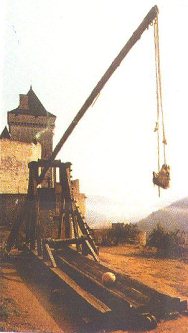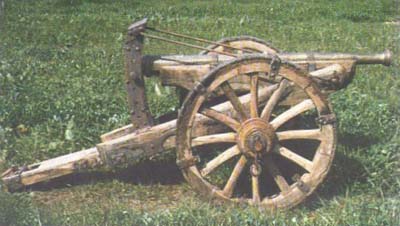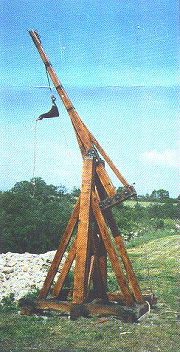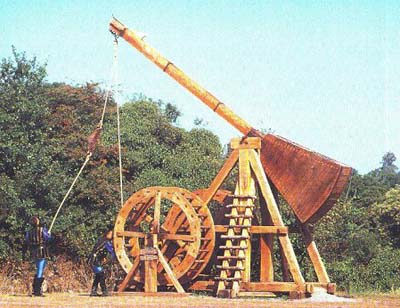In France there are many châteaux-museums that offer considerable
interest to students of medieval history. In particular, due to the
works of ARMÉDIÉVAL, certain châteaux provide a unique opportunity to
see reconstructions and actual firing-demonstrations of the war engines
and early gun-powder artillery of the Middle Ages. As none of the
original, great-sized, pre-gunpowder machines remain, we are dependent,
today, upon the energetic and studious research, and knowledgeable
reconstructions provided by ARMÉDIÉVAL, under the direction of M.
Renaud BEFFEYTE.
M. Renaud BEFFEYTE's began in 1984 to make the first reconstituted trebuchet which was fully operational. It was in complete working order when presented to the press in June 1987.
Reconstructions by others followed two years later, notably in Denmark,
England and the USA. M. BEFFEYTE's reconstructions are by far the most
extensive of any builder of these weapons. His reconstructions also
exhibit a variety of designs that most accurately reflect the weapons
of medieval Europe.
Many tourists to France are unaware of these exhibits
and the demonstrations. The purpose of this page is to promote the
awareness of the exhibits and to provide information to anyone
interested in visiting the museums or in learning of ARMÉDIÉVAL's work.
It should be appreciated that each of the
châteaux-museums scattered throughout France also exhibits the richness
of the heritage of their local regions and communities.
LOCATIONS:
In particular, this is the case for the following regional departments, communities and châteaux:
At the end of this web page will be the latest information on demonstrations and additional information on specific sites.
Following are some pictures from the ARMÉDIÉVAL brochure:
 |
Arbalète à Tours:
This crew-operated crossbow has a range over 300 meters, and is capable of penetrating 3 men and 1 horse.
A composite bow (Modèle de Quedlembourg, 1336).
|
|
 |
|
Trébuchet, XII - XV centuries: this one throws a 56 kg projectal 212 meters.
|
|
 |
|
Couillard: used as a hurling machine up to the XVI century, well after the appearance of he bombard (1324).
|
|
 |
|
Fauconneau (XVI century): muzzle loaded.
|
|
 |
|
Beffroi (assault tower), 17 meters high, on wheels, with a draw bridge on top.
|
|
 |
|
Bricole: defensive 'artillery' (from XII to XV centuries).
|
|
 |
Squirrel-cage Mangonneau.
Château de Gilles De Rais [called
"Bluebeard (Barbe-Bleue)" (XII and XVI centuries). Conservatoire des
Machines de Guerre Médiévales.
TIFFAUGES - Vendée.
|
|
M. Renaud Beffeyte is constructor and holder of
copyright of all the medieval machines pictured in this webpage. He may
be contacted for his publications and on other matters at:

Attention!
As of 2000, there is a new page (only
in French) that explains a range of ARMÉDIÉVAL projects, which include
education and development of medieval festive events.
|
1998 TREBUCHET PROJECT in SCOTLAND
M. Beffeyte provided ARMÉDIÉVAL's expertise in the construction of a replica of Edward I's WAR-WOLF
trebuchet. The project was sponsored by WGBH-Boston and organized by
the Timber Framers Guild of America. Construction of two siege machines
and test firings took place in front of Urguhart Castle, Loch Ness. Visit page summary.
FIRING DEMONSTRATIONS and CHÂTEAUX VISITS:
The operating hours for visiting specific châteaux vary. While many are
open all year around, the dates and times for specific locations need
to be obtained through regular travel bureaus. Once in France, one of
the many "bonjour" offices of the Ministère du Tourisme (where they now
have English speaking personnel) should be able to help. Normally, it
is a best to make a phone call if there is a long distance to the
location, as some of the museums in the regions away from large cities
can have irregular hours.
Though some demonstrations take place throughout the year, at specified
days and times, most are conducted between late May through September.
Specific times for specific cited below are from previous brochures,
and are provided only for rough-planning. Times and open days should be confirmed before making a visit.
Since these sites are not usually found on road maps, the following
information attempts to reference their locations from more commonly
designated towns. Note: it is important to associate the regional
district with the names, as there are often more than one town with the
same name. A reference map helps identify the general locations in France of the locations described below.
Le Château de Saint-Brisson, LOIRET.
The structure began as a medieval XII century castle, built on a
promontory overlooking the southern slope of the Loire Valley. Located
approximately 60 km southeast from Orléans, and about 7km from the town
of Gien, to the south and across the Loire.
The château belonged to several distinguished families.
Louis VI visited it in 1135, and Philippe Auguste in 1181. Visitors can
enjoy a walk in the grounds and a guided tour of the stately residence.
Reproductions of medieval war machines are exhibited in the castle
moats, and visitors can enjoy scheduled firing demonstrations (usually
on Sundays, in summer, at 1530 and 1530 hours).
Le Château de Saint-Brisson
45500 Saint-Brisson-sur-Loire
LOIRET - 45
FRANCE
Tel: 38. 36. 71. 29; Fax: 38. 36. 77. 29.
Le Château de Gilles de Retz's chateau at Tiffauges, VENDÉE.
It
is located southeast of Nantes and northwest of Mortagne. The château
occupies a magnificent position, at the junction of the Sévre and the
Crume rivers. With its surrounding walls, covering approximately 3
hectars, it is a typical medieval château fort.
At the end of the Hundred Years' War it was owned by
Gilles de Rais, a recognized military leader and one of the
'companions' of Jeanne d'Arc. De Rais withdrew from active service
before the war was over and retired as a very wealthy lord to his
favorite dwelling, Tiffauges. It was here that he was known to have
practiced alchemy. The château exhibits an alchemist's laboratory of
the era. De Rais was later charged with cruel crimes and executed.
Recent scholarship suggests that he may have been the victim of a
greedy duc and powerful enemies who wanted to confiscate his wealth.
Nevertheless, Gilles de Rais led a very unusual life. Although
Tiffauges is referred to as "Bluebeard's (Barbe-Bleue)" château, there
is no historical basis to connect Gilles de Retz (Rais) to Blubeard.
Today, Tiffauges is famous for having one of the best
demonstrations of medieval war machines and early artillery. It is part
of a siege camp with catapults, giant cross-bows, cannons, belfry,
battering ram, and many other such weapons. There are nearly daily
firing demonstrations along with mounted knights and other warriors
exhibiting techniques of medieval warfare.
Château de Gilles de Rais (dit Barbe-Blue)
Vendée - 85
FRANCE
Tel: 51.65.70.51; Fax: 51.65.73.31
Open all year:
March, April, October and November: afternoons of Sundays and holidays.
May, June, and September: daily (except Wednesday) 10h to 12h, and 14h to 18h.
Firing of machines from 11h and 15h
plus 17h on Sundays and holidays.
July and August: daily 10h to 12h and 14h to 19h.
Firing of machines from 11h, 15h, and 17h.
Le Château de Castelnaud, DORDOGNE.
It is located opposite the town of Beynac, 10 km southwest of
Sarlat, overlooking the Dordogne River. A French military scholar
identified Castelnaud as one of "the most complete museums on warfare
of the Middle Ages ."
The château was founded in the twelfth century. In 1214 it
was taken and dismanteled by Simon de Montfort, a leader in the crusade
against the Albigensians. Castelnaud was recognized as the a feudal
domaine of the duke of Aquitaine, Henri III of England. The outer wall
was constructed in this era. It forms a spur on the side exposed to
attack.
In 1368, Magne de Castelnaud, the only heir, married the lord
Nompar de Caumont. The Caumonts became the lords of Castelnaud. In
1405, they took the side of the English. The château was lively
disputed by the French, who held Beynac until their successful siege,
ordered by Charles VII, in 1442.
After the war, Castelnaud was
restored to Caumonts and they were allowed to reinforce it. Brandelis
de Caumont, with his son, François, embellished Castelnaud: crowning
the donjon [central tower] by a gallery of of 'machicoulis', an
artillery tower, main living quarters, and lower outter-wall.
During he Wars of Religion, the château was entrusted to the
great Huguenot captain, Geoffroy de Vivans, born at Castelnaud. At the
end of the reign of Henri IV, Nompar de Caumont, the marquis de La
Force and future Marshal of France, constructed the last fortifications
on the side of the hill. Abandoned during the Revolution, the château
became a stone quarry around 1832. Its redemption and restoration began
in 1967. Today it is the most visited château in Aquitaine.
Exhibits include a collection of arms and armor of the
Middle Ages; donjon furnished with fifteenth century furniture;
reconstructed war machines; dioramas and videos; an animatied model of
the siege of 1442; childrens' library; and scenic view.
Open all year:
March, April, October, to the middle of November*: 10h to 18h.
May, June, September: 10h to 19h.
July, August: 9h to 20h.
Off Season: closed on Saturday, otherwise 14h to 17h.
Ask about the possibilities of group reservations.
There are some guided tours in English
Château de Castelnaud
2425 Castelnaud-la-Chapelle
Dordogne - 24
FRANCE
Tel: 53.29.57.08; fax [telescope] 53.28.94.94
Le Château Calmont d'Olt, AVEYRON.
Located 30 km north of Rodez, just 3km from the small town of
Espalion, on the Lot river.This structure dates from the ninth century.
It was the medieval fortress of the barons of Calmont, who enlarged it
over the years. The outter wall was constructed in the fifteenth
century. It was not used after the seventeenth century, and fell in
ruins. It now is an archelogical site for the study of such castle, or
château, forts.
The site holds an impressive panoramic view of the Lot valley. It has a
functioning machine and a reconstructed medieval siege camp.
Château Calmont d'Olt
12500 Espalion
Aveyron - 12
FRANCE
Tel: 65.48.22.09; 65.44.15.89
Open 9h to 19h, 1 May through 30 October
Closed Thursdays and Fridays in May, June, September, October.
Open upon request to groups.
Larressingle, GERS.
Small fortified medieval village, south of Nérac, on N. 130, 5 km
from Condom-en-Armagnac. The village is surrounding with a
reconstructed 13th century siege camp with throwing weapons. The camp
is open to visitors, who, at time may take part in the demonstrations.
Much more information can be found at the very informative Larressingle
web site La Cité des Machines.
Larressingle
Gers - 32
FRANCE
Hours unknown.
Provins, SEINE ET MARNE.
Just southeast of Paris and east of Fontainebleau is the medieval town
of Provins. Much of the town has retained (or carefully reconstructed)
the twelfth-century fortifications and other structures. The location
is the site of several year-around re-enactments of medieval
activities: jousts, firing of war machines, falconery, and festivals.
The site can be visited by train from Paris-East station, or by car. The National Route (N) 19 from Paris goes through Provins.
Provins Maison du Visiteur
Chemin de Villecran, B.P. 44
77482 PROVINS (Seine et Marne)
FRANCE
Tel: 01.64.60.26.26; Fax: 01.64.60.11.97
MINITEL: 3615 PROVINS (2,23 FF per minute)
Return to begining of ARMÉDIÉVAL page.
|